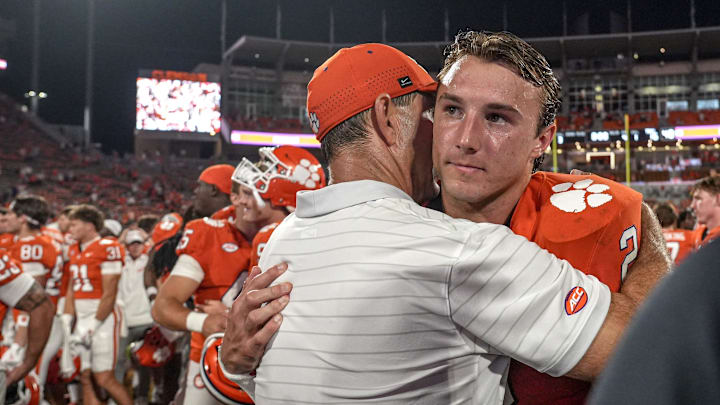In the golden era of Clemson football — roughly 2015 through 2020 — the quarterback position was more than just a role; it was a lynchpin of the national championship machine. Under Dabo Swinney, Clemson wasn’t just winning — it was doing so in big games, against the toughest competition. The picture was pristine: Trevor Lawrence going 31-2 against P5 teams, Deshaun Watson at 28-3, Kelly Bryant and Tajh Boyd similarly dominating whenever the opposition rose above the mid-tier. Those were QBs who didn’t just survive P5 matchups — they owned them.
Then came the turning point. After Lawrence’s departure, the numbers begin to slip. DJ Uiagalelei’s 18-6 is still good, but it lacks the cushion, the easy inevitability of victory, that his predecessors enjoyed. And now, with Cade Klubnik sitting at 15-11, with nearly as many losses as some of those earlier QBs had in half the time, the narrative is evident: This isn’t the same Clemson anymore.
This is certainly not all on him, but it’s nevertheless an incredible stat: https://t.co/kFK4wRqdBP pic.twitter.com/QSZZLYSHjf
— 💫🅰️♈️🆔 (@ADavidHaleJoint) September 15, 2025
What the Decline Really Means
Here are the key dimensions illuminated by the crossing of these win/lose lines:
Mental Edge & Expectation: Lawrence, Watson, Boyd — they came into games confident. They were battle-tested. Opponents expected Clemson to be at its best; the Tigers usually were. As losses creep in, that expectation flips, and with it, the margin for error shrinks. Hustle, finesse, clutch throws — all those intangibles were present then, and begin eroding when you lose just a few too many.
Roster & Talent Gaps: It’s hard to replicate the caliber of supporting casts of the Lawrence or Watson eras. Elite receivers, stable offensive lines, and backs who make defenses pay. Once that drops, even a very good quarterback becomes more exposed, more prone to turnovers or missed windows, especially vs. P5 defenses who are more disciplined.
Scheme, Coaching, & Adaptation: Offenses evolve. Defenses do, too. Clemson’s offense that once overwhelmed — through big plays, intermediate passes, explosive runs — now runs into more packages that take advantage of weaker spots. Defensive coordinators study tape, find creases: blitz packages, man coverage schemes, pressure up the middle. Without elite QB play (in experience, anticipation, arm strength) those creases become game-deciders.
Recruiting & Retention Pressure: When you see losses mount in marquee matchups, it affects recruiting, morale, and the ability to keep momentum. Players want to be in programs with both pedigree and upward trajectory. Teens assessing Clemson today see a program with more questions — not just zeal, but performance.
Margin for Error Shrinks: In the life of elite programs, flawless days fade. A dropped pass, a bad snap, a mistimed route — all of that was manageable when you had immovable dominance and elite QBs. Now, with erosion in quarterback consistency, it’s those small mistakes that blow up. Clubs that used to win almost every close game are losing more of them.
Evidence of the Crack
Losing P5 matchups more often: Going from nearly undefeated in those games to now having a record that’s almost even under Klubnik versus P5 matchups is telling.
Statistical dropoffs: In 2024, Klubnik had a strong season (3,639 yards, 36 TDs, 6 interceptions). Good numbers. But the context changes.
Reuters
He still gets exposed in big defensive moments, and the losses in big games are more frequent.
Program explosiveness has decayed: In the Clemson Spring Guide, it’s noted that from 2018-20 the Tigers were among the very best in yard-per-play metrics; subsequently, they dropped toward the bottom of Power 5 schools in those same metrics. explosive plays, rate of big chunks, etc.
Clemson Tigers Official Athletics Site
Close games no longer tilting “Clemson”: The margin wins in tight, high pressure games — once part of the lore — are less reliably in Clemson’s favor now. Losses mount in those disguise “should-win” or “need-win” games.
The Turning Point: Where the Drop Began
The transition from Trevor Lawrence to DJ Uiagalelei marks the inflection point. Lawrence left a high bar. Uiagalelei won a lot, had flashes, but could never consistently match Lawrence’s “too good to be beat” aura. Then, as defenses adjusted, supporting personnel shifted, and the weight of high expectations stayed, but margin for error didn’t — that was when wins vs. P5 started becoming harder to earn.
What It Looks Like Going Forward
If this decline continues:
Clemson might drift from being a weekly Top 10/QB1 type team into more of a “contender with flaws.” Still dangerous, still able to win a lot, but no longer the automatic threat in every season.
Quarterback recruiting and development will become even more vital. Finding QBs who can thrive without elite surrounding casts.
Coaching may adjust: perhaps simpler schemes, more protection for QBs; generational talent might be required again to push back toward dominance.
Fans and media will increasingly judge those 15-11 types of QB performances (vs. P5) against their great predecessors, fueling debate about whether this is a cyclical dip or a longer structural decline.
Conclusion
The stat from David Hale isn’t just about wins and losses. It signals a shift: the ladder from “top 3 national title hopeful” to “good, but beatable on any big stage” has grown steeper. Trevor Lawrence, Deshaun Watson, Kelly Bryant — they were rare. Cade Klubnik is good, but the larger pattern shows Clemson QBs today simply don’t win P5 games with the same frequency, the same margin, or the same aura.
If Clemson wants to get back to that mountaintop, the QB position has to be rebuilt or re-enhanced — not just in talent, but in consistency, coaching, scheme, and supporting cast. Otherwise, that decline becomes a new normal.
